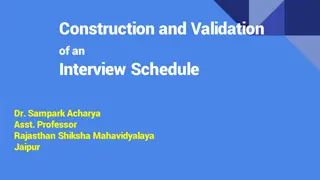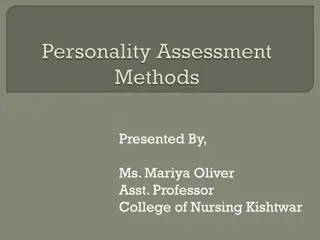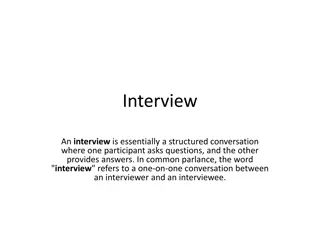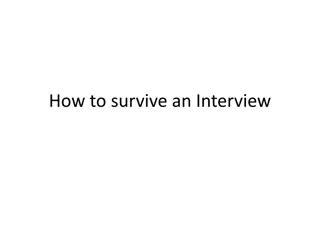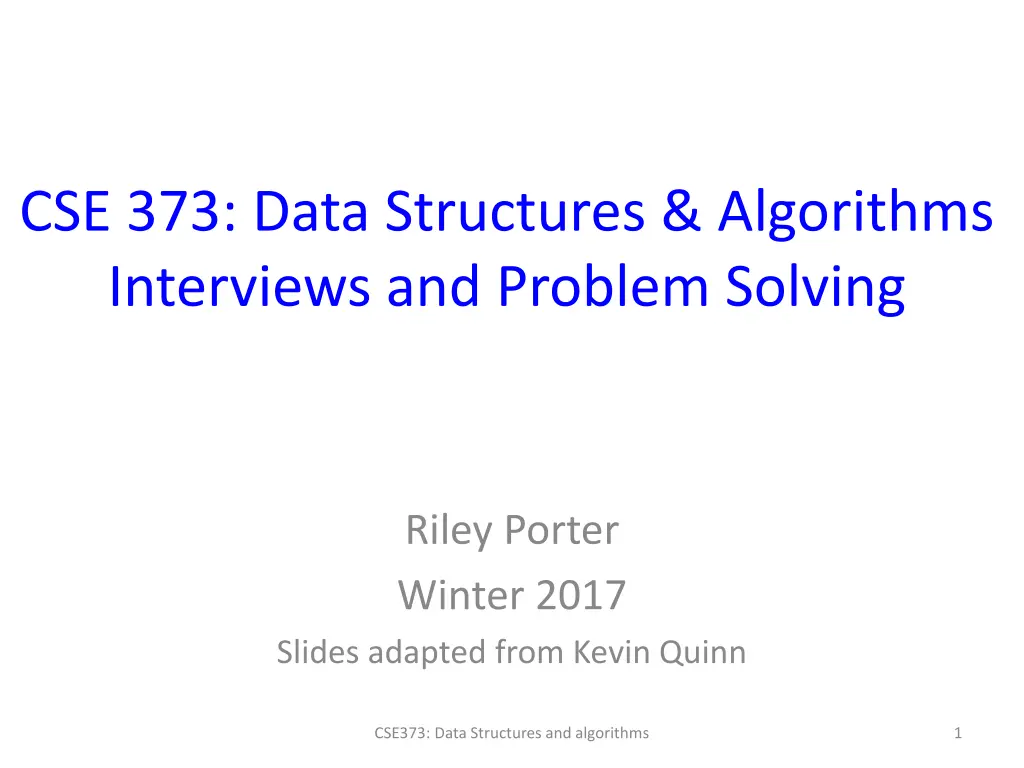
Mastering Technical Interviews: Coding Tips and Breakdown
Learn valuable insights on technical interviews, including coding tips, breakdown structure, and how to excel in coding parts. Get ready to ace your next technical interview with confidence!
Uploaded on | 3 Views
Download Presentation

Please find below an Image/Link to download the presentation.
The content on the website is provided AS IS for your information and personal use only. It may not be sold, licensed, or shared on other websites without obtaining consent from the author. If you encounter any issues during the download, it is possible that the publisher has removed the file from their server.
You are allowed to download the files provided on this website for personal or commercial use, subject to the condition that they are used lawfully. All files are the property of their respective owners.
The content on the website is provided AS IS for your information and personal use only. It may not be sold, licensed, or shared on other websites without obtaining consent from the author.
E N D
Presentation Transcript
CSE 373: Data Structures & Algorithms Interviews and Problem Solving Riley Porter Winter 2017 Slides adapted from Kevin Quinn CSE373: Data Structures and algorithms 1
Course Logistics HW6 due Friday Final review session next Monday (Exam resources updated on the website after class today)
Todays Outline What even is a technical interview? How do you break down problems and what do they want you to demonstrate Practice for technical interviews
Getting Hired 1. Apply Online or at Career Fair work on your resume, put projects you liked, relevant classes you took, programming languages you know, relevant work experience 2. Phone Interview / Phone Screen can be with recruiter, usually is just short technical engineering interview can be screen shared coding, get a headset or headphones with mic stand up! smile! be personable, it does matter 3. Onsite Technical Interviews can be all day between 2-5 interviews mostly generic tech interviews can sometimes have 1 or 2 system design or design or test interviews CSE373: Data Structures and algorithms 4
Technical Interview Breakdown 1. Introduction (5-10 minutes): basic background projects you ve worked on what you re passionate about and what you want to work on 2. Coding Question(s) (30 minutes - infinity): could be smaller and several, or one large one with many levels problem description and conversation clarifying all parameters constraints, goals, use case, etc. (summarize it) code it, normally on a whiteboard test it if you have time 3. Questions for them (2-5 minutes): how does the company work, how easy is it to move teams, what s the culture like, are they happy, would they choose differently now, are they excited about what they re working on, what is the structure within the company / project CSE373: Data Structures and algorithms 5
Tips for Coding Part of Interview Ask questions (this is a two way street) Verbalize everything. All the things you re thinking Draw pictures before writing code, make sure you ve designed your data structures and how they interact Write pseudocode bulleted list of steps you re going to take before code Analyze runtime and space complexity of your design before coding, maybe iterate on your design, ask input from your interviewer. Ask if it s okay to start with your first design if that s all you can think of, you can improve it if you have time Get to testing, or at least think of test cases as you go and verbalize them Practice writing on a whiteboard, practice writing code out as you talk / think (when done) Analyze if your solution passes the test cases you thought of, run through it to see if you forgot anything, re-analyze the runtime and space complexity CSE373: Data Structures and algorithms 6
When solving: tools at your disposal Over the past 8 weeks we have developed a broad knowledge of data structures and algorithms (I hope): Stacks and Queues Various implementation (Stack/List) PriorityQueues BinaryHeap Dictionaries (Maps) HashMap, TreeMap Trees Balanced (AVL), BST Union Find Uptrees Graphs Directed/Undirected, Acyclic/Cyclic, Weighted Dijkstra s, BFS, DFS Topological Sort Minimum Spanning Trees Sorting CSE373: Data Structures and algorithms 7
When solving: everything is a trade-off Very rarely is there a perfect solution in the real world. Often must prioritize things like: space vs. time simplicity vs. robustness Understanding the ins and outs of each structure allows you to make informed design decisions that balance these trade-offs. CSE373: Data Structures and algorithms 8
When solving: dont reinvent the wheel More often than not, the problem you are trying to solve is not entirely unique Usually it is possible to simplify a problem down to a few core principles Important operations Space/time constraints Once you have found an appropriate analog, allow the well-thought out design to assist you Example: AVL trees handle balancing for you Example: Hash tables will handle collisions for you CSE373: Data Structures and algorithms 9
When solving: sometimes simple is best In this class, we have lived and died by the asymptotic runtime, however this is not always the case Sometimes simple and readable code is more important Sometimes you know very distinct things about your input Sorting input that is almost entirely sorted Dictionary of elements that have nearly identical keys It can be more important to get a complete solution or have a complete discussion, it depends, ask your interviewer CSE373: Data Structures and algorithms 10
Question 1: Given a value x and an array of integers, determine whether two of the numbers add up to x : Questions you should have asked me: 1) Is the array in any particular order? 2) Should I consider the case where adding two large numbers could cause an overflow? 3) Is space a factor, in other words, can I use an additional structure(s)? 4) Is this method going to be called frequently with different/the same value of x ? 5) About how many values should I expect to see in the array, or is that unspecified? 6) Will x always be a positive value? What about the values in the array? 7) Can I assume the array won t always be empty, what if its null? CSE373: Data Structures and algorithms 11
Why these questions matter! 1) Is the array in any particular order? If the array is already sorted, then this question becomes a lot easier, and can be done in O(n) time. 2) Should I consider the case where adding two large numbers could cause an overflow? If the integers are very large, I should use something other than ints to store my results, such as double or longs, or else I could get inconsistent results. 3) Is space a factor, in other words, can I use an additional structure(s)? If space is not a factor, then it might be better to leave the original array alone, and instead sort the array in a separate structure. Or even use a BST representation. CSE373: Data Structures and algorithms 12
Why these questions matter! 1) Is this method going to be called frequently with different/the same value of x ? This is a *great* question. If the client will be calling this frequently, it might make more sense to store a copy of the sorted array to prevent needing to re- sort it every time. This could drastically speed-up frequent calls. This process is called memoization. 2) About how many values should I expect to see in the array, or is that unspecified? Often times, it is safe to assume that there could be any range of values (or in our case, asymptotically very many). However, this is not always the case. Our solution to this problem may be different if we knew that there were always exactly 12 values in our array. CSE373: Data Structures and algorithms 13
Question 1.5 Given an array of integers, return a new array of the same values without any duplicates CSE373: Data Structures and algorithms 14
Question 1.5 Given an array of integers, return a new array of the same values without any duplicates create set, s create set, s for each value, x in for each value, x in input_array add x to s add x to s create new array, result create new array, result for each value, x in s: for each value, x in s: add x to result add x to result return result return result input_array: : CSE373: Data Structures and algorithms 15
Question 2: Given an array that contains the values 1 through n two times each, find the one number that is contained only 1 time. CSE373: Data Structures and algorithms 16
Question 2: Given an array that contains the values 1 through n two times each, find the one number that is contained only 1 time. create map from strings create map from strings- -> >ints for each value, x in for each value, x in input_array if ! if !map.contains map.contains(x): map.put map.put(x, 0) (x, 0) map.put map.put(x, (x, map.get map.get(x) + 1) ints, map , map input_array: : (x): (x) + 1) f for each key in map, key: or each key in map, key: if if map.get map.get(key) == 1: return key return key (key) == 1: CSE373: Data Structures and algorithms 17
Question 3: Given a list of integers, find the highest value obtainable by concatenating them together. For example: given [9, 918, 917], result = 9918917 For example: given [1, 112, 113], result = 1131121 CSE373: Data Structures and algorithms 18
Question 3: Given a list of integers, find the highest value obtainable by concatenating them together. For example: given [9, 918, 917], result = 9918917 For example: given [1, 112, 113], result = 1131121 - -Convert all numbers to strings Convert all numbers to strings - -Sort numbers based on largest first Sort numbers based on largest first number, break ties by moving on to next number, break ties by moving on to next digit if its greater than the previous digit if its greater than the previous CSE373: Data Structures and algorithms 19
Question 4: Given a very large file of integers (more than you can store in memory), return a list of the largest 100 numbers in the file CSE373: Data Structures and algorithms 20
Question 4: Given a very large file of integers (more than you can store in memory), return a list of the largest 100 numbers in the file Create min Create min- -heap, h Add first 100 values to h Add first 100 values to h while there are remaining numbers: while there are remaining numbers: x = next number x = next number if x > if x > h.getMin h.getMin(): h.deleteMin h.deleteMin() h.add h.add(x) (x) heap, h (): () c create new list, l reate new list, l w while hile h.isEmpty h.isEmpty(): l.add l.add( (h.deleteMin h.deleteMin()) return l return l (): ()) CSE373: Data Structures and algorithms 21
Question 5 Given an unsorted array of values, find the 2nd biggest value in the array. (Harder alternative) Find the k th biggest value in the array CSE373: Data Structures and algorithms 22
Question 5 Given an unsorted array of values, find the 2nd biggest value in the array. s sort ort input_array input_array r return eturn input_array input_array[ [len len 2] 2] m max = ax = - -infinity infinity 2 2nd _max = - -infinity for each value, v in for each value, v in input_array if v > max: if v > max: 2 2nd _max = max max = v max = v r return 2 eturn 2nd _max nd_max = infinity input_array: : nd_max = max nd_max m max ax- -heap h = heap h = heapify h.removeMax h.removeMax() Return Return h.removeMax h.removeMax() heapify( (input_array input_array) ) () () CSE373: Data Structures and algorithms 23
Question 6 Given a list of strings, write a method that returns the frequency of the word with the highest frequency. (Harder version) Given a list of strings, write a method that returns a sorted list of words based on frequency CSE373: Data Structures and algorithms 24
Question 6 Given a list of strings, write a method that returns the frequency of the word with the highest frequency. m max = 0 ax = 0 map from string map from string- -> >int for each string, s: for each string, s: if ! if !map.contains map.contains(s): map.put map.put(s,0) map.put map.put(s, (s, map.get if if map.get map.get(s) > max: max = 0 max = 0 int, map , map (s): (s,0) map.get(s) + 1) (s) + 1) (s) > max: CSE373: Data Structures and algorithms 25
Question 7: Given an array of strings that are each sorted lexicographically, determine the order of characters in the given alphabet. For example, given the english alphabet, the ordering is: a,b,c,d,e,f . . . x,y,x . Your output should be the lexicographic order of only the characters that were found in the input strings. For example: input = [xyz, yk, zk, xm, my], then the output would be [x,m,y,z,k] CSE373: Data Structures and algorithms 26
Todays Takeaways Interviewing takes practice actually practice, interview for companies you don t care about first Breathe, it s supposed to be fun It s a conversation between you and the interviewer Sometimes you don t click, that s not your fault. Remember all of your tools ask questions, pseudocode, draw out solutions, talk through your thought process, use extra storage if it makes it faster, think about sorting if that is useful CSE373: Data Structures and algorithms 27






